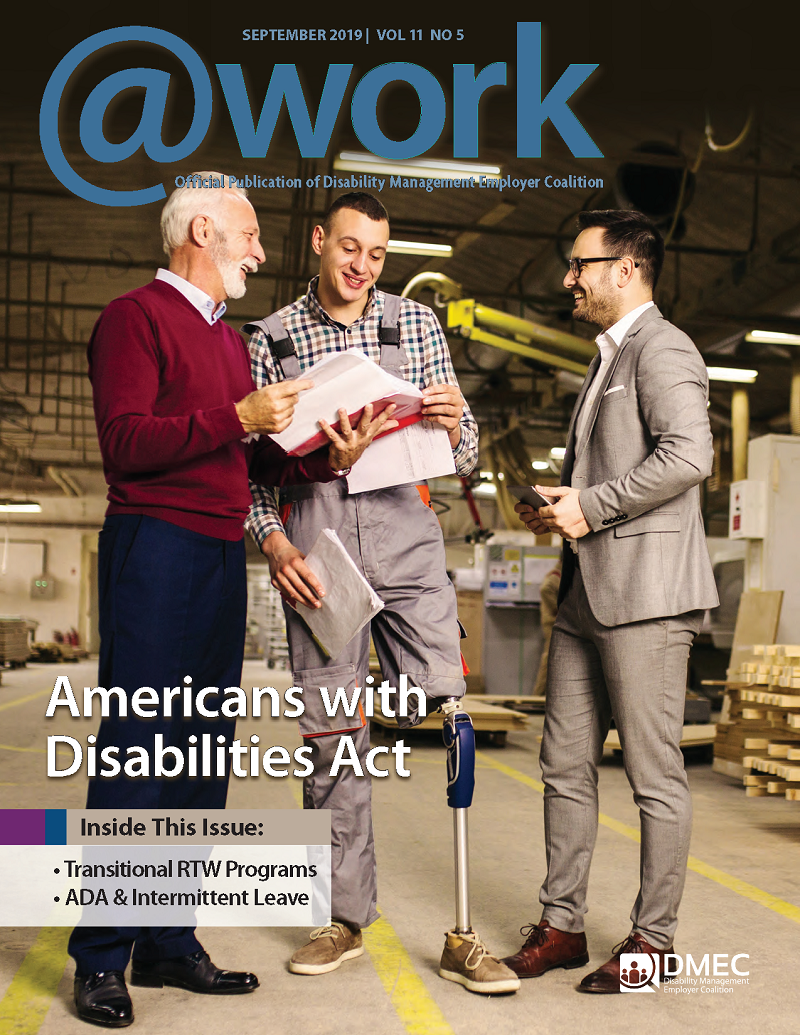
September 2019
Americans with Disabilities Act
Return-to-work (RTW) and stay-at-work (SAW) programs are essential components of a successful and compliant Americans with Disabilities (ADA) program. This issue of @Work magazine addresses best practices for RTW and SAW programs as well as other important pieces of your overall ADA strategy, including technology, job descriptions, physical demands analysis, and much more.
Features
Overcoming Transitional RTW Program Development Challenges
Employers are increasingly challenged to effectively manage employee absence, and to protect their organizations from direct and indirect costs associated with absenteeism. A formal transitional RTW program will help reduce the challenge of decreased productivity and lower the organization’s risk and legal exposure. Read more.

Is Intermittent Leave a Reasonable Accommodation?
Over the last decade, a continuous leave of absence has been widely recognized as a possible accommodation for employees in certain circumstances. As the Equal Employment Opportunity Commission continues to enforce that leave is a valid ADA accommodation, the question remains as to whether employers must allow intermittent leave as an accommodation. Read more.

Spotlight Articles
Program Showcase: ADA Accommodation Tools
Even before the Americans with Disabilities Act (ADA), many employers were already seeking positive stay-at-work and return-to-work outcomes for employees experiencing disabilities. The ADA accommodation process gives us fresh motivation to revisit two important tools for this effort: the physical demands analysis and the ergonomics assessment. Read more.

Compliance Showcase: ADA Interactive Process
The specter of an Equal Employment Opportunity Commission (EEOC) investigation is intimidating. However, armed with the common-sense approaches, employers can reduce their risk of EEOC investigations and defend against claims by the EEOC or employees. Read more.

SAW/RTW Showcase: Job Function Descriptions
The Americans with Disabilities Act Amendments Act (ADAAA) can be difficult to comply with, but there is one key step employers can take to ease the challenge: creating and maintaining complete, accurate employee job descriptions. This step is often overlooked, and it can make a world of difference when it comes to easing the ADAAA compliance burden. Read more.

Compliance Showcase: Service Animal Requests
Will you be ready when your employee insists on bringing Fluffy, a 95-pound German shepherd emotional support animal, to work? Is there a difference between an emotional support animal and a service animal? What is an employer required to do? Read more.

Columns
Absence Matters: Integrated Programs
The vision for a single point of contact, integrated data collection, and specialty case management originally included short-term and long-term disability and workers' compensation. Now included under the expanded scope of integrated absence management are the FMLA, the ADA, and a host of state or local statutory requirements. Read more.

Integrated Absence Management: The ADA and the FMLA
The Americans with Disabilities Act and the Family and Medical Leave Act present some of the biggest absence management compliance challenges for employers. It’s important to understand both the differences and the common turf between these separate laws that frequently intertwine. Read more.

Employer Solutions: ADA Accommodations
When illness, accident, or other disabling issues arise, the decisions you make to care for employees are critical in retaining the talent and ability that brought them onboard to begin with. These do not have to be difficult decisions or expensive solutions. Read more.

FMLA Second and Third Opinions: Decertifying FMLA Leave
Employers often wonder, once they have that “final and binding” third opinion, what they should do about all the absences the employee previously reported as Family and Medical Leave Act leave? Read more.

The Disabled Workforce: Interactive Process Triggers
Employers are fielding an increasing number of requests for accommodation under the Americans with Disabilities Act (ADA). To maintain compliance, employers must understand when they are triggered to enter into the ADA interactive process and the importance of maintaining consistent processes. Read more.

Absence Minded: ADA Compliance
Most human resource professionals understand that the Americans with Disabilities Act has significant compliance requirements. But sometimes company leadership didn’t get the same memo, managers are resistant, or perhaps the HR department is going through a tough transition. Read more.

Technology and Absence Management: Accommodation Modules
Non-compliance with the Americans with Disabilities Act (ADA) can be costly for employers. Fortunately, a wealth of technology is available to support the interactive accommodation process and strengthen your accommodation program. Read more.

Disability in the Workplace: Common-Sense ADAAA Compliance
While employers continue to grapple with the varied challenges of the ADA Amendments Act (ADAAA) compliance, there are three key processes in all ADAAA-qualifying situations. Read more.

Mental Health At Work: The ADA and Accommodations
When an employee’s thinking and/or behavior is substantially limited, this individual is disabled under the ADA. If an employer can provide a reasonable accommodation enabling the employee to perform the job properly and with acceptable behavior, a legal obligation to do so may exist. In some cases, however, it is a challenge to determine if the employee can be accommodated. Read more.

Aligning Workers’ Compensation: The ADA and the Home Office
How many of your employees work from home part time, or even full time? How do you handle issues under the Americans with Disabilities Act involving this portion of your workforce? Adapting the reasonable accommodation process to work from home requests has two parts. Read more.

Departments
The CEO Desk: ADA Utopia?
What would an Americans with Disabilities Act utopia with a robust stay-at-work and return-to-work program look like? First, our jobs would be much easier when we needed to accommodate disabled employees, and second, it would be part of normal business processes for employees to return to work following an illness or injury. Read more.

DMEC News: September 2019
This month's DMEC News features a recap of the 2019 DMEC Annual Conference, the 2019 DMEC Partnership and Emerging Leader Award winners, and a new state and local leave resource rolling out for DMEC members in September. Read more.

Compliance Memos: September 2019
The September 2019 compliance memos cover preventive healthcare services and health savings accounts, FMLA notice requirements, and city paid sick leave ordinances. Read more.





